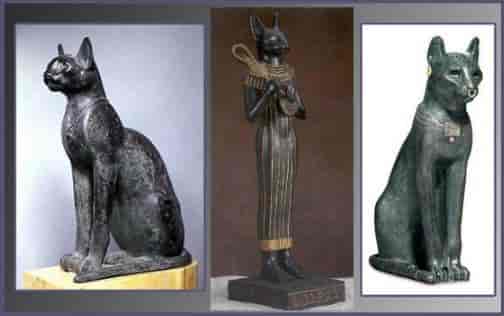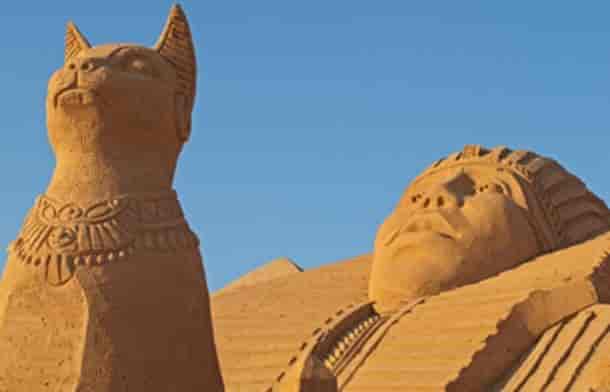Egyptian name: Bastet
Greek name: Bastis
Representation: Cat or female with the head of a cat or lioness
Bastet: goddess of Bubastis (meaning “House of Bastet”), located in the Nile delta, was the centre place of worship to Bastet devotees.
She worshiped since the Second Dynasty (2890 BC). She represented safety and friendship of houses and shrines.
Bastet also represented abundance and was the lady of pleasure, possessing all the peaceful aspects of dangerous goddesses like Sekhmet.

Why is Bastet important?
Bastet was protective of the cats and, therefore, enemy of the snakes, fundamentally of Apophis (Apophis is the Great Serpent, enemy of the sun god Ra) to which she attacks with her claws protecting her father Atum.
Originally she symbolized the warm fertility of the sun, as opposed to Sekhmet, which is the scorching heat. She was called “Lady of the East” and was related to Sekhmet, “Lady of the West.”
During the New Kingdom Bastet was made a goddess of war and associated with the sun. She was said to be the wife and daughter of Atum-Ra, or daughter of Osiris and Isis. She is also considered the personification of the soul of Isis.

What is the symbol of Bastet?
Represented as a female with a cat’s head, although previously she had a lion’s head, as seen in the mortuary temple of Niuserre.
In her warrior appearance, she was a lioness with green skin and in this aspect was associated with sunlight. She was a solar goddess until the identification of the Greeks with her lunar goddess Artemis.
It was from the tenth century BC when she adopted household characters and that is when she begins to appear as a domestic cat.
Bastet also represented with gold earrings on the ears and nose; sometimes she had an aegis in her right hand. She becomes patron saint of festivals, held in April and May, where she was usual to get drunk. During the festivals it was forbidden to hunt lions to avoid her anger.
In Bubastis, on the eastern side of the Delta, a party called drunkenness was celebrated in which large quantities of wine were consumed, remembering that the goddess was drunk to placate her anger (in her association with Sekhmet).
In her temple there were cats sacred that were supposed to be the incarnation of the goddess and, when they died, they were mummified. In Bubastis a cemetery was found with thousands of mummified cats.
In addition to Bubastis, she was also venerated in Memphis (assimilated to Sekhmet), Heliopolis (assimilated to Tefnut), and Thebes (assimilated to Mut).

What does Bastet hold in her hands?
Bastet was usually depicted as a woman with a domesticated cat’s head, although she often had a lion’s head. She is never depicted as human and is known to hold various items:
- Ankh: a symbol of life who Bastet often held.
- Papyrus wand: again often held by Bastet.
- Sistrum: a musical instrument often held by Bastet and Hathor.
- Was-scepter: a symbol of power or dominion sometimes held by Bastet in pictures of her in Per-Bast.

Sanctuary
Herodotus, a specialist in Greek history who visited Egypt in the fifth century BC, portrayed the sanctuary of Bastet from top to bottom:
“Apart from the passage, Bubastis is surrounded by two channels of the waterway that reach the passage of the sanctuary, none of which merges with the other, in light of the fact that one goes from one side and the second from other side.
The canal is one hundred feet wide and on its banks the trees are tight. The sanctuary, which is at the focal point of the city, cannot be seen from all sides while walking, and this happens in light of the fact that the city has grown, while the sanctuary has not moved, but remains in its unique place.
Within the fenced area there is a forest with expansive trees, planted around a work in which is the statue of Bastet, a stone and about three stadiums in length, It leads east through people in the general market. The street is about 400 feet wide, and is flanked by tall trees.
Drive to the sanctuary of Hermes. “Herodotus, II, 59-60






